Search results for: 'bronze'
-
 Roman surgical probe made of silver
Roman surgical probe made of silverThe so-called specillum was standard issue for roman doctors. Similar probes are still in use today. Ancient surgical instruments made of silver are extremely rare.
Price: on request Rare frog fibula
Rare frog fibulaZoomorphic fibula dating to the Roman Principate. Very nice enameled work. Rare variant of this popular fibula type from Roman Gaul.
Price: on request Disc brooch from Roman Britain
Disc brooch from Roman BritainNicely enameled brooch with a Romano-Celtic sunburst design. From the 2nd century AD. Published in two stardard works on ancient brooches by Richard Hattatt.
Price: on request Enameled disc brooch from Britain
Enameled disc brooch from BritainColourful enameled brooch from the Roman Imperial period. Published in two stardard works on ancient brooches by Richard Hattatt.
Price: on request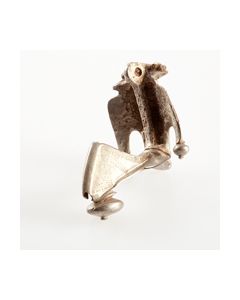 Kräftig profilierte Silberfibel, 2. bis 3. Jh. n. Chr.
Kräftig profilierte Silberfibel, 2. bis 3. Jh. n. Chr.Römische Fibel vom Typ der kräftig profilierten Fibeln. Massives Silber, 34,2g, 100 bis 250 n. Chr. Museumswürdiger Zustand.
Price: on request Roman silver fibula
Roman silver fibulaInteresting type of brooch from the Roman Imperial period. Nice specimen made of silver.
Price: on request Römische Silberfibel aus Pannonien
Römische Silberfibel aus PannonienGewandnadel vom Typ der kräftig profilierten Fibeln bzw. der Trompetenfibeln. Spezifische Variante der Jahre 200 bis 250 n. Chr. aus den pannonischen Provinzen.
Price: on request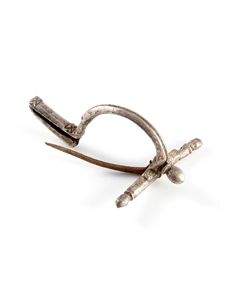 Römische Zwiebelknopf-Fibel aus Silber
Römische Zwiebelknopf-Fibel aus SilberBeliebter Fibeltyp des 3. und 4. Jh. n. Chr. Typischerweise von römischen Männern getragen. Der Träger dieser Fibel aus Silber hatte sicher eine gehobene soziale Stellung.
Price: on request Brooch from Roman Britain
Brooch from Roman BritainA rare mixture of cicada fibula and trumpet fibula, from the 2nd century. Found on the Isle of Wight.
Price: on request Roman Hod Hill brooch
Roman Hod Hill broochMade around the year 100 and found on the Isle of Wight, after the Roman conquest of Britain.
Price: on request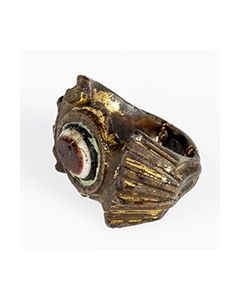 Roman finger ring with imitated agate
Roman finger ring with imitated agateMassive gold plated finger ring dating to the Late Roman Imperial period. The ring impresses with a particularly nice multi-layer glass gem in red, white and black.
Price: on request Rechteck-Fibel aus dem 2. bis 3. Jh.
Rechteck-Fibel aus dem 2. bis 3. Jh.Antike römische Brosche. Dekorierte Platte mit Resten von Email. Typ aus dem 2. bis 3. Jh. n. Chr., 20mm x 33mm.
Price: on request Gorgeous Roman Imperial fibula
Gorgeous Roman Imperial fibulaThe large bow is dominated by colourful enamel. It is a brooch type that developed during the 1st cent. AD in Central Europe.
Price: on request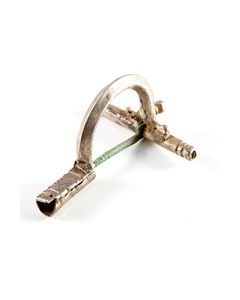 Römische Zwiebelknopf-Fibel aus Silber
Römische Zwiebelknopf-Fibel aus SilberBeliebter Fibeltyp des 3. und 4. Jh. n. Chr. Typischerweise von römischen Männern getragen. Der Träger dieser Fibel aus Silber hatte sicher eine gehobene soziale Stellung.
Price: on request Roman plate brooch
Roman plate broochBeautiful example with orange and turquoise enamel. A find from 2nd century Roman Britain.
Price: on request Gallo-Roman animal fibula
Gallo-Roman animal fibulaZoomorphe Fibel mit Wildtier als Motiv. Schmuckstück mit religiöser Symbolik, vergleichbar einem Kreuzanhänger bei heutigen Christen. Gefertigt im 1. bis 3. Jh. n. Chr. in Gallien.
Price: on request Roman sandal sole type fibula
Roman sandal sole type fibulaDie Form wird in der Literatur als Schuh- oder Sandalensohle bezeichnet. Der sehr dekorative Fibeltyp war extrem beliebt und im zweiten Jahrhundert weit verbreitet. Er stammt aus den nördlichen römischen Provinzen.
Price: on request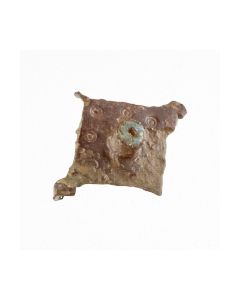 Roman fibula from the Richard Hattatt collection
Roman fibula from the Richard Hattatt collectionLozenge-shaped ancient roman fibula. The piece is published in the standard work "Iron Age and Roman Brooches". Found in Britain.
Price: on request Roman fibula from the Richard Hattatt collection
Roman fibula from the Richard Hattatt collectionLozenge-shaped ancient roman fibula. The piece is published in the standard work "Iron Age and Roman Brooches". Found in Norfolk, England.
Price: on request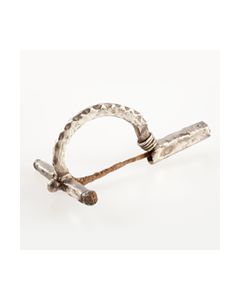 Silberne Armbrust-Fibel um 300 n. Chr.
Silberne Armbrust-Fibel um 300 n. Chr.Römische Fibel vom Typ der Armbrust-Fibeln. Massives Silber, 14,6g, 280 bis 320 n. Chr. Hervorragender Zustand.
Price: on request Roman discus fibula with color glass paste
Roman discus fibula with color glass pasteSpannende Fibel mit Sterndekor und Glaspaste. Eine Weiterentwicklung keltischen Kunsthandwerks in der Zeit römischer Herrschaft. Gut dokumentierter Typ aus dem 2. Jh. v. Chr. mit Verbreitung in weiten Teilen Europas.
Price: on request Römische Zwiebelknopffibel
Römische ZwiebelknopffibelMassive Zwiebelknopffibel aus Bronze. 23,2 Gramm, aus dem 4 Jh. n. Chr. Ungewöhnliche, kantige Zwiebelknopfverzierung.
Price: on request Roman glass rod
Roman glass rodThe object had a function as a distaff, a tool for spinning. Particularly noteworthy is the beautiful spiral decoration and the complete preservation of the fragile material. From the Roman Imperial period.
Price: on request Roman intaglio with goddess of victory
Roman intaglio with goddess of victoryThe glass paste features Victoria writing the names of victors in battle on a large shield.
Price: on request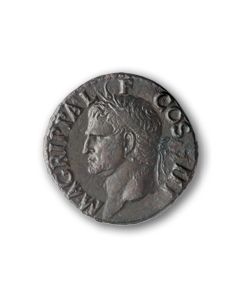 As des Agrippa
As des AgrippaAV: Kopf mit corona rostrata; RV: Neptun mit Delphin. Kabinettstück in vorzüglicher Erhaltung mit toller gleichmäßiger brauner Patina.
Price: on request Marc Antony legionary Denarius from Wishanger hoard
Marc Antony legionary Denarius from Wishanger hoardFound 2021 in East Hampshire, UK. Best condition of the five Marc Antony denarii in the hoard. The hoard is a very impressive proof of the fact that coins were in circulation for up to several centuries in the Roman era.
Price: on request Julius Caesar Denarius from Wishanger hoard
Julius Caesar Denarius from Wishanger hoardElephant trampling on horned snake. Found 2021 in East Hampshire, UK. The hoard is a very impressive proof of the fact that coins were in circulation for up to several centuries in the Roman era.
Price: on request Tiberius denarius (Tribute Penny) from Wishanger hoard
Tiberius denarius (Tribute Penny) from Wishanger hoardFound 2021 in East Hampshire, UK. The hoard is a very impressive proof of the fact that coins were in circulation for up to several centuries in the Roman era.
Price: on request Marc Antony legionary Denarius from Wishanger hoard
Marc Antony legionary Denarius from Wishanger hoardFound 2021 in East Hampshire, UK. The hoard is a very impressive proof of the fact that coins were in circulation for up to several centuries in the Roman era.
Price: on request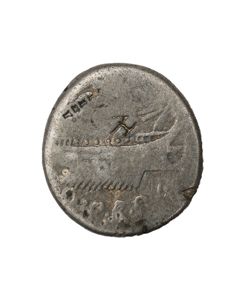 Marc Antony legionary Denarius from Wishanger hoard
Marc Antony legionary Denarius from Wishanger hoardFound 2021 in East Hampshire, UK. The hoard is a very impressive proof of the fact that coins were in circulation for up to several centuries in the Roman era.
Price: on request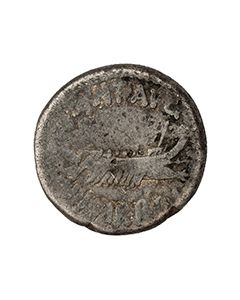 Marc Antony legionary Denarius from Wishanger hoard
Marc Antony legionary Denarius from Wishanger hoardFound 2021 in East Hampshire, UK. The hoard is a very impressive proof of the fact that coins were in circulation for up to several centuries in the Roman era.
Price: on request Vespasian denarius from Wishanger hoard
Vespasian denarius from Wishanger hoardFound 2021 in East Hampshire, UK. The hoard is a very impressive proof of the fact that coins were in circulation for up to several centuries in the Roman era.
Price: on request Marc Antony legionary Denarius from Wishanger hoard
Marc Antony legionary Denarius from Wishanger hoardLEG V or X. Found 2021 in East Hampshire, UK. The hoard is a very impressive proof of the fact that coins were in circulation for up to several centuries in the Roman era.
Price: on request Roman Republican denarius from Wishanger hoard
Roman Republican denarius from Wishanger hoardAnonymous, 2nd century BC. Found 2021 in East Hampshire, UK. Best condition of the five Marc Antony denarii in the hoard. The hoard is a very impressive proof of the fact that coins were in circulation for up to several centuries in the Roman era.
Price: on request Roman Republican denarius with galley from Wishanger hoard
Roman Republican denarius with galley from Wishanger hoardObverse showing janiform heads of the Dioscuri. Found 2021 in East Hampshire, UK. The hoard is a very impressive proof of the fact that coins were in circulation for up to several centuries in the Roman era.
Price: on request Roman Republican denarius of Renius from Wishanger hoard
Roman Republican denarius of Renius from Wishanger hoardBiga driven by goats on reverse. Found 2021 in East Hampshire, UK. The hoard is a very impressive proof of the fact that coins were in circulation for up to several centuries in the Roman era.
Price: on request

